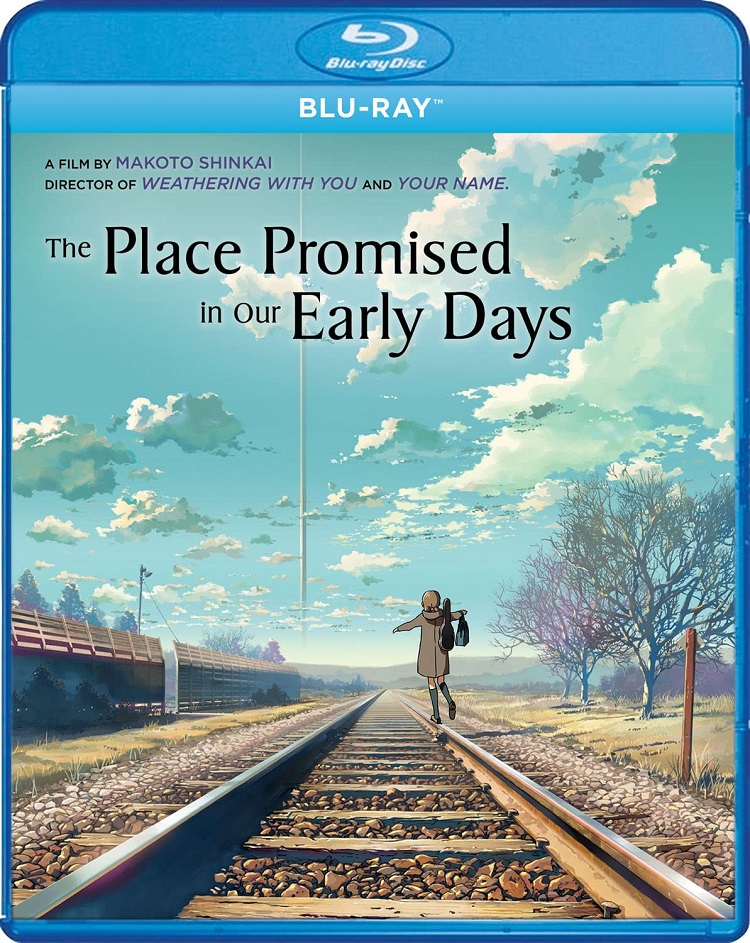
The Place Promised in our Early Days is set on an alternative Earth on the brink of war. Some part of Japan has been conquered by “The Union” (Soviet Union). One of these places, Hokkaido, a northern Japanese island, becomes home to a mysterious tower that reaches almost out into space. The purpose of the tower, discerned only decades after its existence, seems to revolve around the intersection of parallel universes. It channels matter from other universes in a radius around the tower. Someday it may begin to grow and expand all over the world.
Of course, the movie is basically a teenage romance.
Seriously, the film’s story is about two teenage boys, Hiroki and Takuya, obsessed with two things: building their own airplane, and their classmate, Sayuri. Obsessed is overstating it. They’re both in love with Sayuri in low-key ways, and neither of them have the courage to do anything about it.
Eventually, one of them brings her along to the airstrip where they work to earn money for airplane parts. She sees their airplane and learns of their secret mission: They want to fly by the tower on Hokkaido, just to see it with their own eyes. Sayuri makes them promise to take her.
Then, she disappears. The work on the plane stops, and the boys drift apart as friends. Three years later, Takuya is working in an NSA-sponsored intelligence agency that monitors and attempts to understand the tower. Hiroki is a student who keeps to himself. The disappearance of Sayuri broke their hearts, and their friendship.
Describing the film makes it sound like a fairly typical plot-heavy anime movie. And to be fair, there’s a lot of jargon and pseudo-politics in the dialogue. But it doesn’t have the action-orientation of most sci-fi anime. The science fiction is mostly a backdrop to a story of the power of youthful love, and dreams.
The entire first third of the film is mostly slice-of-life teenage school stuff. I almost wrote teenage drama, but there isn’t much drama to be had, since there isn’t much conflict. There’s one sequence where Sayuri almost falls off a roof, but it turns out not to have been any real danger.
Hiroko and Tanuka work on their plane. They work at the air strip. Eventually Sayuri comes around, and they show her things. Her presence elevates their silly teenage flying dreams with a bit of female grace, and their promise to take her with them turns a kind of dare into a kind of dream.
The international politics and the science fiction chicanery (which, and this is the third time I’ve seen the film, still barely make a lick of sense to me) are there to give weight to this teenage dream. With Sayuri gone, the boys have no point to their ambition anymore. And when they find her again, the secret of her disappearance means it might be dangerous for her to go near the tower. Not just for herself but for the entire world.
For anime, the palette and tone of the art can be just as important as the action to the tone of the time. The Place Promised in Our Early Days is pretty. It’s wistful. Green grass and blue sky are the primary color scheme.
It was director Makoto Shinkai’s feature film debut. He has since become an anime film super-star with Your Name and Weathering With You being massive hits, both inside and out of Japan. The Place Promised in our Early Days looks like a prototype of those films’ themes and concerns. It’s about teenage love and separation, with a science-fiction story illustrating the characters emotional problems. Those other films have much better integrated plots, with stories that make more sense and characters who are better defined. Sayuri is the best girl because she is the best girl, not because of anything about her personality.
It also comes from the early era of digitally animated Japanese films. Some aspects of the visuals have aged well, but the character animations are a little ill-defined and the color palette can be a little too pastel and dull.
I’m honestly ambivalent about The Place Promised in our Early Days. I’ve mentioned I’ve seen the film three times. The first time I found it endlessly dull. The second I caught the feeling and rhythm of it and was more enraptured, even if I didn’t fully understand what was going on.
My final assessment is that the film has a very specific and interesting tone. It often looks beautiful, even though it is hampered by technology. What it doesn’t have is a powerful enough story, or clear enough story telling. It’s entertaining and creates a warm, sentimental feeling. But Makoto Shinkai would take the themes he played with here and developed them into better films later.
The Place Promised in our Early Days has been released on Blu-ray by GKIDS. Extras on disc include a video interview with director Makoto Shinkai (13 min); a video interview with the Japanese voice cast (33 min); and a trailer collection (7 min).